
|   |

|   |
 e-mail: leelakaverivenkat@gmail.com Nityananda: The one-legged miracle dancer Photos courtesy: Kalashram November 16, 2018 That no hurdle barring ultimate death can hold back the determined dancer can be seen from the life of Nityananda Das. A young enthusiastic student of Odissi in Bhubaneswar, learning under his Guru Bimbadhar Das, the lad showed real promise of a bright future as an artist, till misfortune in the shape of a grievous fall, resulted in an operation robbing him of one leg. Moving on crutches, a sobbing Nityananda greeted his teacher who angrily looked at this mess of self pity standing in front of him, and in one fell sweep taking away the crutch, ordered him to join the dance class and learn to dance with what he had! Thus started hours of indomitable courage and effort, by both teacher and taught to get the body used to balancing on one leg. And today watching the aplomb with which Nityananda performs, one can only come away astonished at the tenacity and resilience of the human material. 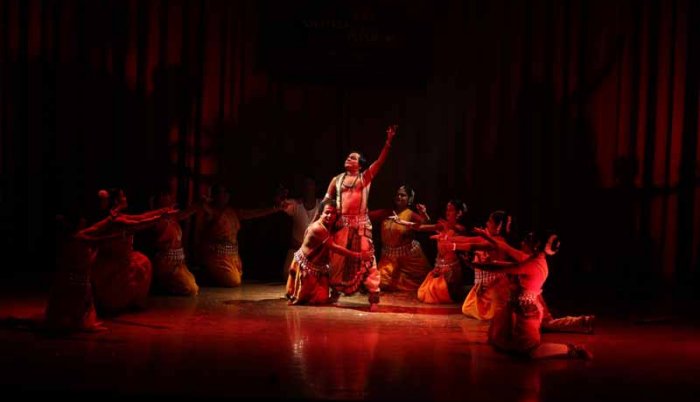 Guru Dakshina The Guru Kripa two-day programme at the Satya Sai auditorium in Delhi, organised by Kalashram, the Odissi institution where Nityananda is coaching students along with his guru Bimbadhar Das, was proof of what fortitude and guts can achieve. After the Pushpanjali presented by artists of Kalashram (Odissi school from Bhubaneswar), the short dance drama presentation was based on the theme of the life of Nityananda. The real and the virtual came together with both Guru Bimbadhar Das and Nityananda dancing their own lived stories, filling the respective role each has played. Occasionally though, emotions which tended to overcome the dancers had to be reined in. Nityananda Das and Bijay Kumar Das dancing as a twosome was wonderful to behold! How with one leg, the dancer manages to execute the torso isolations that the Odissi technique calls for, is amazing! And the Kalashram students joined in the prayer to the Guru. Indeed but for a Guru who would not accept defeat for his disciple and who had no room for regrets in his scheme of life, Nityananda could not have fought against adversity of such a grave nature robbing him of a basic limb without which dance cannot be thought of. 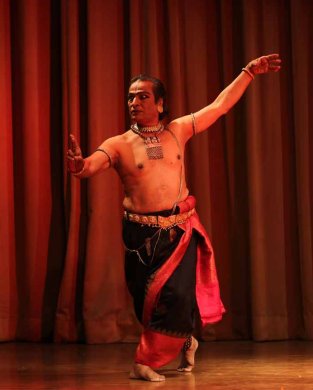 Guru Jaya Rama Rao Aditi Gupta, Abhiram Ajith and T. Reddi Lakshmi, three well trained disciples of Kuchipudi Guru Jaya Rama Rao, who was honoured with the Guru Gangadhar Pradhan Award by Guru Bimbadhar Das, projecting commendable group unity and technical finish presented a Jatiswaram in Hamsadhwani set to adi talam. This was followed by Shiva Sthuthi in a ragamalika and talamalika rendered by Guru Jaya Rama Rao, who has a flair for the veera rasa/tandava roles. And age, happily, has not lessened the vitality of communicative power! The jathiswaram in Vasanta, the concluding number rendered by students Umang, Sanjana, Vidushi and Sangita, apart from the 'panchanadai' rhythm saw the dancers sometimes engaged in only footwork, set to the music and also a well designed finishing sequence dancing on the rim of the brass plate, the signature item of Kuchipudi. 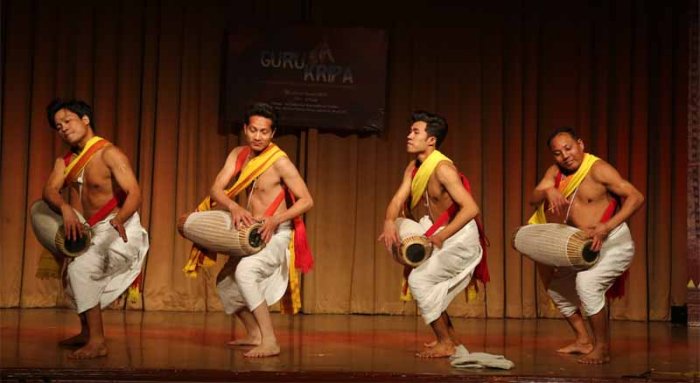 Pung Cholom The Pung and Dhol Cholom, of the Manipuri artistes from Imphal, not to speak of sequences from their martial art Thanga Ta, were much admired by the audience, for their nimble footed grace coupled with high artistry. 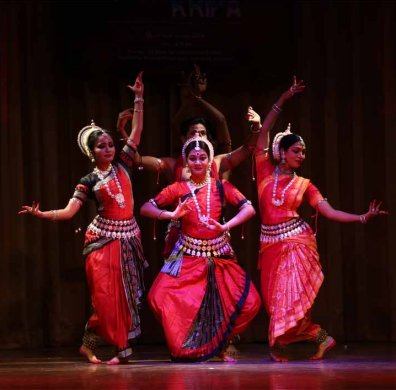 Krishnaya Tubhyam Namah Well trained solo dancers of Odissi Academy coming together to form a group under the title 'Odissi Darshan' combined with professional sensitivity in 'Krishnaya Tubhyam Namah' , the dance effort based on one verse from the Gita Govinda - "Vedanuddharate jagannihate Bhoogolamudbibhrate......dashaakrtikrte Krishnaya tubhyam namah" where, in telling brevity poet Jayadeva, from saviour of the Vedas as the Matsya (fish) to Kalki, pays homage to all the ten incarnations of Vishnu for upholding righteousness by destroying evil. A well known choreography by their late Guru Gangadhar Pradhan, the disciples did full justice to the composition, the arresting frozen group designs concluding each avatar held in perfect control, with the 'Krishnaya Tubhyam Namah' salutation, providing the link between avatars according to the music of Subhash Pani. 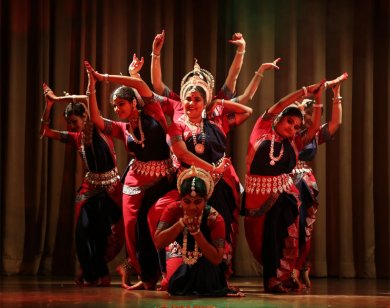 Siva Panchakshara The second evening began with an ambitious sharing of the performance space by solo artists of five traditions- Bharatanatyam (Tamal Das), Kathak (Suman Choudhary), Odissi (Samir Kumar Behera), Manipuri (Kamaljeet Wahengbam) and Kuchipudi (Prabir Dutta) in what was titled Panchadhara. It turned out to be nondescript dancing together, with very little of the identity of the respective forms given sufficient time and space to be expressed in a definitive fashion. Priya Sakha wherein the relationship between the almighty one worships and the devotee becomes one of deep bonding friendship, was a moving item with Guru Nityananda Das and Guru Bijay Kumar Das - the ease with which the two dancers combined heightening the power of the dialogue. Again, seeing Nityananda's ability in visualising the Odissi profile in his dance movement, given his single leg, left many in the audience surprised. 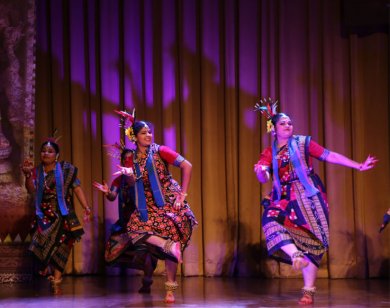 Sambalpuri dance In what turned out to be a kind of variety entertainment, mime artist Moinul Haque created quite a stir with how his white painted face reflected myriad emotions. A versatile performer though one would like to experience themes more pleasant than over eating and indigestion and regurgitating! The rendition by Bharatanatyam exponent Geeta Chandran's disciples Amritasruthi Radhakrishnan, Radhika Kathal and Madhura Bhrushundi as the three incarnations of Devi in "Devi Treyi" in clean dance lines as well as the way choreography was designed, is worthy of praise. Taking the stage in a solo presentation, Geeta Chandran in "Aigiri Nandini" brought out all aspects of the Devi, the music as moving as the dance, with the dance combining nritta and abhinaya.  Writing on the dance scene for the last forty years, Leela Venkataraman's incisive comments on performances of all dance forms, participation in dance discussions both in India and abroad, and as a regular contributor to Hindu Friday Review, journals like Sruti and Nartanam, makes her voice respected for its balanced critiquing. She is the author of several books like Indian Classical dance: Tradition in Transition, Classical Dance in India and Indian Classical dance: The Renaissance and Beyond. Post your comments Please provide your name and email id when you use the Anonymous profile in the blog to post a comment. All appropriate comments posted with name & email id in the blog will also be featured in the site. |